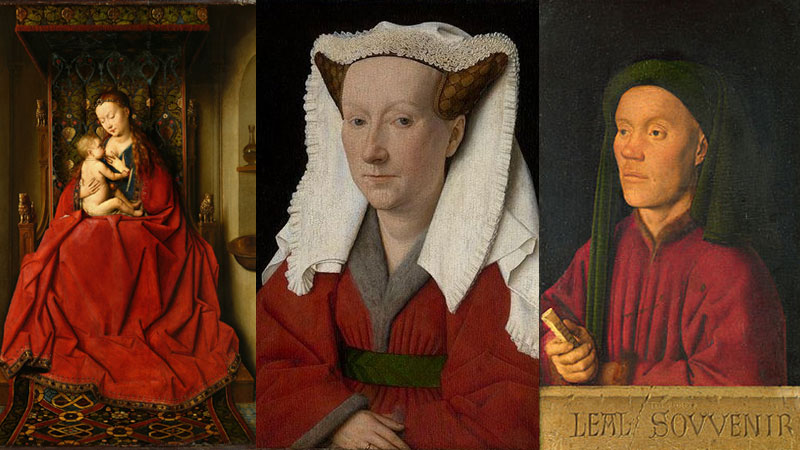
Jan van Eyck stands as a towering figure of the Northern Renaissance, celebrated for his groundbreaking contributions to oil painting.
With only around 20 surviving works attributed to him, each piece showcases an extraordinary level of detail and realism that continues to captivate audiences today.
His innovative techniques in manipulating light, texture, and color set new standards that influenced generations of artists.
Among his most iconic masterpieces are the Arnolfini Portrait and the Ghent Altarpiece, both of which exemplify his ability to convey deep emotion and intricate storytelling through visual art.
Van Eyck’s paintings not only reflect the cultural and spiritual ethos of his time but also reveal his unparalleled skill in creating lifelike representations.
In this article, we delve into the ten most famous paintings by Jan van Eyck, exploring their significance and the lasting impact they’ve had on the art world.
1. Arnolfini Portrait
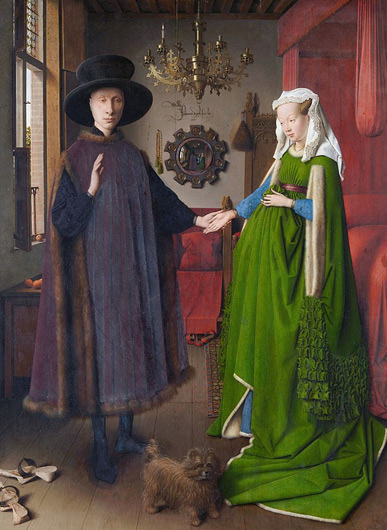
Arnolfini Portrait, painted in 1434, features Giovanni di Nicolao Arnolfini and his wife in a domestic setting.
It showcases Van Eyck’s remarkable attention to detail, from the intricate textures of their garments to the glistening chandelier.
The convex mirror reflects historical significance, hinting at their marital vows and fidelity. This iconic piece illustrates Van Eyck’s innovative use of oil paint, allowing for breathtaking depth and lifelike colors.
Currently displayed at the National Gallery in London, this portrait remains one of the most analyzed works in art history.
2. Ghent Altarpiece

The Ghent Altarpiece, created between 1420 and 1432, is a monumental polyptych that showcases Van Eyck’s mastery in oil painting.
Commissioned by Jodocus Vijdts and Elisabeth Borluut, this piece consists of 12 panels featuring intricately detailed biblical figures.
Van Eyck, alongside his brother Hubert, worked on the altarpiece, portraying themes of Redemption and Salvation.
Known for its historical significance, it has been the most stolen artwork in history, symbolizing the enduring impact of Van Eyck’s artistry.
3. Portrait of a Man (Self Portrait?)

Jan van Eyck’s Portrait of a Man (1433) raises intriguing questions about identity. The painting features a man wearing a turban and gazing directly at viewers, which many believe symbolizes the artist himself.
This self-portrait showcases Van Eyck’s impressive skill in capturing human expression and detail. The meticulous rendering highlights the subject’s facial stubble and realistic textures, illustrating the artist’s eye for minutiae.
Displaying confidence through the intense gaze, this work not only exemplifies Van Eyck’s technique but also hints at his social standing in the art world.
4. Madonna of Chancellor Rolin

Madonna of Chancellor Rolin, painted around 1435, depicts Chancellor Nicolas Rolin in prayer before the Virgin Mary.
It showcases Van Eyck’s meticulous detail colors. The scene is set in a grand loggia, enhanced by ornate columns and intricate bas-reliefs.
The Virgin Mary holds the infant Jesus while an angel crowns her, symbolizing divine grace. The landscape in the background represents Rolin’s hometown, further emphasizing the personal connection to the viewer.
This masterpiece captures the intersection of spirituality and realism, highlighting Van Eyck’s innovative approach.
5. Virgin and Child with Canon van der Paele
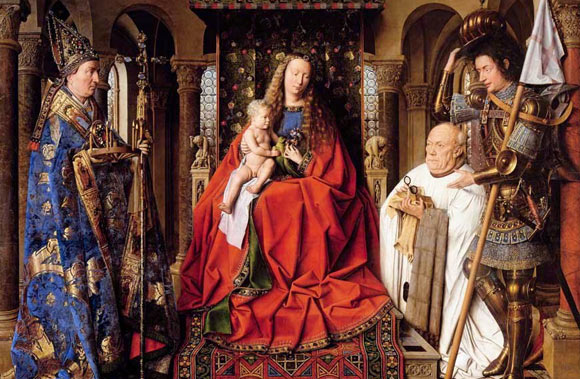
Virgin and Child with Canon van der Paele, painted around 1436, portrays Canon Joris van der Paele presenting a beautifully rendered Virgin Mary and the infant Jesus.
The composition’s richness shines through Van Eyck’s precise details colors. The figures are set against a delicately crafted background, enhancing the sense of depth and reality.
The scene signifies divine presence, suggesting a communion between the sacred and the viewer. This painting is a noteworthy example of Van Eyck’s innovative use of oil paints to create lifelike textures and emotional resonance.
6. Annunciation
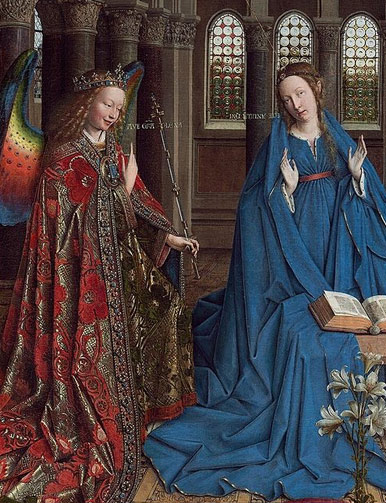
The Annunciation, completed around 1434-1436, presents a breathtaking depiction of the moment the Angel Gabriel announces to the Virgin Mary that she will bear the Son of God.
The painting’s exquisite details, from the flowing fabrics to the ethereal light, demonstrate Van Eyck’s mastery of oil paint. Intricately composed, each element is rich in symbolism, emphasizing divine grace.
The serene expressions of both figures and the richly adorned interior capture the sacred moment with stunning realism, showcasing Van Eyck’s innovative techniques and profound spirituality.
7. Portrait of a Man with a Blue Chaperon

Jan van Eyck’s Portrait of a Man with a Blue Chaperon depicts a serene man donning a distinctive blue chaperon, holding a ring that catches the viewer’s attention.
Created around 1430, this painting showcases Van Eyck’s expertise in texture and detail. The subject’s direct gaze invites viewers into an intimate connection, while the rich colors and soft lighting enhance the lifelike quality.
Many art historians suggest this work may be a self-portrait, indicated by the artist’s prominent signature, adding to its intrigue in the art world.
8. Léal Souvenir
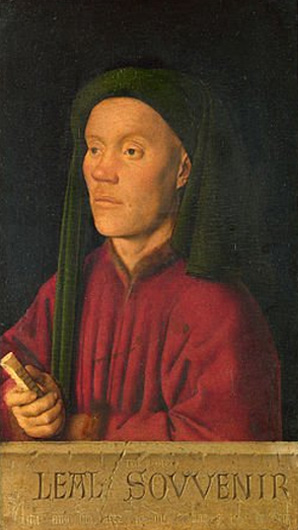
Léal Souvenir, painted around 1432, showcases a young man turned slightly to the right, which creates a sense of intimacy. He wears a blue chaperon and holds a ring, suggesting themes of fidelity and remembrance.
Van Eyck’s meticulous attention to detail is evident in the intricate patterns of the clothing and the rich textures that convey depth.
The serene expression of the subject invites viewers to ponder his thoughts, highlighting Van Eyck’s skill in capturing human emotion and personality.
This work exemplifies his innovative oil painting techniques, reinforcing his status as a master of the Northern Renaissance.
9. Portrait of Margaret van Eyck
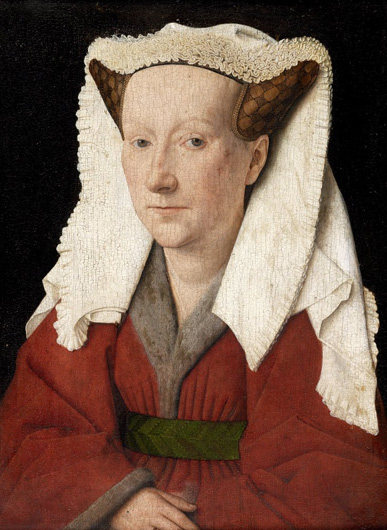
Portrait of Margaret van Eyck, completed in 1439, showcases the artist’s wife with remarkable intimacy. The painting emphasizes her delicate features and intricate headdress, reflecting Van Eyck’s meticulous attention to detail.
The subject, adorned in a red gown with gray fur lining, faces the viewer at a slight angle against a dark background, enhancing her prominence.
This work illustrates Van Eyck’s ability to infuse warmth into portraiture, revealing both the personality of his wife and his deep affection.
The oversized head relative to her body highlights Van Eyck’s unique stylistic choices, setting it apart in Northern Renaissance art.
10. Lucca Madonna
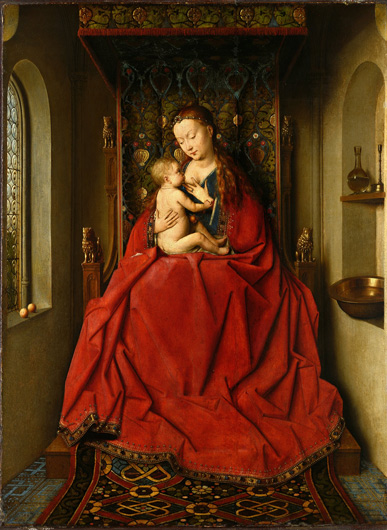
Lucca Madonna, painted around 1436, showcases Jan van Eyck’s exquisite artistry with the Virgin Mary and Child. This work emanates a sense of warmth, with Mary enthroned amid a richly detailed setting.
Van Eyck’s meticulous attention to texture, from Mary’s garments to the intricate canopy overhead, highlights his skill in oil painting.
This piece, intended for personal devotion, reflects his ability to infuse emotional depth into sacred subjects, making it a significant work in the Northern Renaissance.
Currently housed in the Stadel Museum in Frankfurt, it embodies Van Eyck’s innovative approach and lasting impact.






